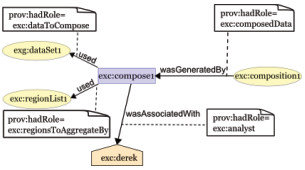https://qillknows.wordpress.com/
In the previous part (PROV-DM Case Study (part 1)), we have identified several entities, activities, and agents, depicted in a picture below.

Now, let’s look in depth on how the entities have been used in and generated activities. Based on the picture above, we know that activity exc:compose1 used entities exc:regionList1 and exg:dataset1; however, the picture doesn’t give use information about what function these entities have played in the processing. There are several functions involved in the activity exc compose1, which known as Roles in provenance. Those roles are:
•The data to be composed (exc:dataToCompose),
•The regions to aggregate by (exc:regionsToAggregateBy),
•The resulting composed data (exc:composedData).
In addition, extra information has emerged that Derek was an analyst whose responsible is to determine how the data should be composed. Thus, one role should be attached for Derek: The analyst doing the composition (exc:analyst). See below picture.

Later, we discovered that our dataset, exg:dataset1 has been revised to a new dataset, exg:dataset2. Consequently, we have a new chart which was generated by our the new dataset, exg:dataset2.

Our new dataset, exg:dataset2 was created by a person named Edith. Edith made a correction of our old dataset by performing several instructions. So, we have information of:
•The correction activity (exg:correct1),
•The person who corrected it, Edith (exg:edith),
•The correction instructions (exg:instructions).

We can also add extra information about how long the correction took place (time). Therefore, the start and end time are added in our activity exg:correct1.

references:
•http://www.w3.org/TR/2013/NOTEprovoverview20130430/